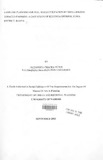| dc.description.abstract | Tobacco production in Kenya under the aegis of the British America Tobacco (BAT)
Company has created a tobacco growing community peasantry that has long been ignored
by social scientists and regional planners. Yet, tobacco farming has had profound
implication to both the physical and social environment on living conditions of the
peasants while wider context a lot of literature on there exists literature on tobacco
production and its economic gains for the peasants, a gap exist pertaining on mechanism
of production does exist, the relation between people and their physical environment
remains a yawning gap in planning in Kenya.
Many scholars argue that agriculture intensification does not always lead to deforestation
or even degradation, however, tobacco farming does. Most people overlook the fact that
overuse of the land and resources for commercial purposes, leads to the degradation of
environment.
The objective of the study was to determine the effect of tobacco on vegetation cover and
explored alternative approaches to overcoming the problem of deforestation in Kegonga.
A sociological inquiry was carried using Structured questionnaires to solicit information
from households. A randomly selected sample of 80 from Kegonga Division was used.
Data was analyzed using the Statistical Package for Social Sciences (SPSS). Among the
findings it was found that fuelwood shortage for curing tobacco is prevalent in Kegonga.
Farmers resort to buying wood from other farmers or harvest the only vegetation along
the rivers. It was further established that the widespread of the use of wood fuel in the
tobacco has had effects on the environment. It came out from the study that there has
been vegetation change whereby, the original tree cover has been removed mainly for
curing tobacco. In addition, it has encroached onto water courses and has contributed to
seasonal drying up of stream. Collecting companies are not involved in any way to ensure
fuelwood availability. It is therefore recommended that other sources of curing tobacco
be sought like using solar or electricity to sage the environment. | en |

